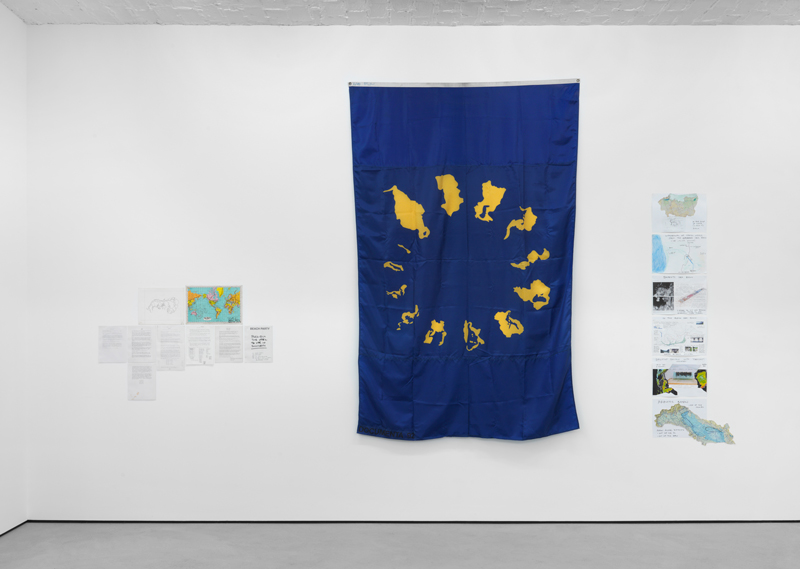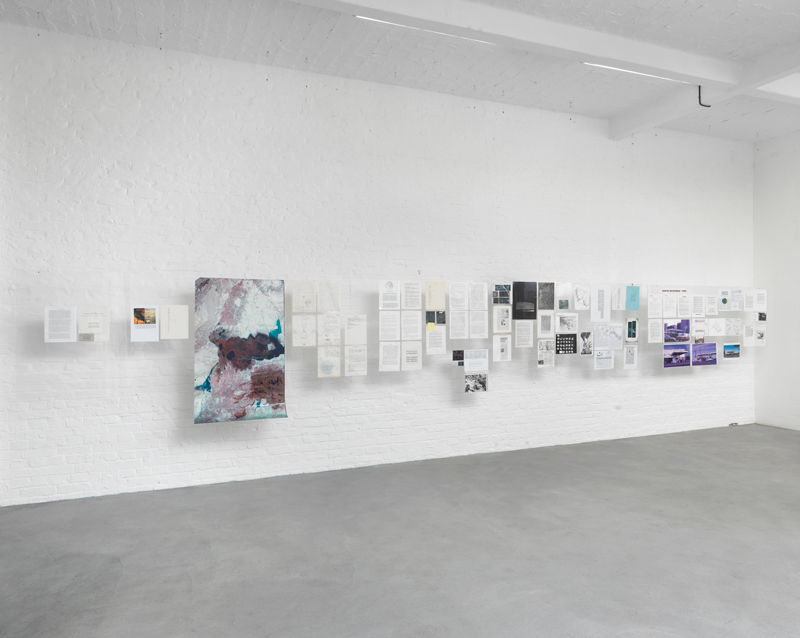Peter Fend
to be built
November 12 - December 19, 2015
Art Agenda
Further documentation
Panel I
Panel II
Panel III
Panel IV
Press release: (1) Ecology would be the dominant issue of my lifetime, notably in desertification, in wild habitat loss, in global warming, in urbanization, in monoculture. (2) Earth art and conceptual art, hot at the time, provided fresh new paradigms for river or ocean engineering. (3) The World Bank, where I had been set up by family connection for a job, was unaware of new art, and therefore unaware of the logic inherent in „Great Western Salt Works“ or even in the systems –drawings of Sol LeWitt, the rapid color sequencing of Paul Sharits, or the wild–animal scenarios of Joseph Beuys. Mustering my ideas for an application to MIT´s regional planning program, I wrote what became the kickoff essay of my career: “Agriculture Ends, Art Takes Over“. I descended into the art world, befriended Dennis Oppenheim, started working for Gordon Matta–Clark and Les Levine and within two years was exhibiting a story-board for earthworks on pan-global scale at Caltech´s Baxter Art Museum, in “Earth Net: An Economic System“ At Caltech, I made the first public exhibit of European Space Agency satellite imagery – even ahead of their official release date. The aim, throughout, was scientific authority with state-of–the–art monitoring technology. In those first years, to make money, I worked at the Fulton Fish Market. In 1979, artist Taro Suzuki asked me to start an artists’ air force with him, and I rejoined with “Space Force“. Soon about ten artists were clustering together on cable TV shows with scenarios of global earth monitoring, for the public. I had been showing and working through Collaborative Projects, Inc. instead of the galleries, and from this spun off a six-person group attempting to reach real-world clients, called “The Offices of Fend, Fitzgibbon, Holzer, Nadin, Prince & Winters“. By this time, all my ideas in architecture, earthworks, offshore renewable-energy structures and even immediate corporal-envelopes had been developed or exhibited, along with my mapping oft he world according to its saltwater (regional sea) basins. The question was: with what legal instrument, what vehicle, shall these ideas be delivered to clients? A lawyer read about me in New York Magazine, regarding adventures at the Fulton Fish Market; he visited “The Offices“ and he explained that it lacked a legal incorporation. That summer, amidst the Real Estate Show and Times Square Show, amidst the normal shift to individual-artist careerism experienced by my colleagues, I founded Ocean Earth Construction and Development Corporation. The first big break for Ocean Earth came in 1982 – with a video exhibition of satellite imagery at The Kitchen, and an outdoor display of ocean basins as satellite monitored sponsored by ...The Lower Manhattan Cultural Council. A Village Voice Arts lead ensued. Three months later, my colleagues in Ocean Earth and I working with that concept of Space Force, realized our fantasy of real–world penetration: we contracted with NBC and the BBC to produce satellite surveys oft the Falklands. The total sale was nearly $25,000, in one day: this was where I had wanted to be. Soon after, we contracted with CBS to cover Lebanon and Beirut. In both cases, however, we discovered that our rapid-spectral sequencing with civil data, based on structuralist film-making ideas of collaborator Paul Sharits, were leading to enormous intelligence findings. We could sift through colors to find grass runways, changing Israeli positions, supply lines – all the hard information of espionage, without using military data or military detail-scrutiny techniques. We were asked to cooperate with intelligence agencies; we refused; then began what I now see as a lifelong game. The next five years were spent mostly outside the United States, with revenue almost entirely from satellite-imagery and analyses sales to nearly all TV companies and international press outlets worldwide. Given difficulties with releasing true stories on conventional media, I funneled data to a high official at the United Nations – until there, too, a scandal broke out. It turned out that this official was not sharing the UN – directed data, for example with Iraq. I exposed him in the International Herald Tribune, then LExpress and New Scientist, and several UN press conferences ensued. Also, more seriously perhaps, Iraq became aware that the UN had been acting wrongly. Dangerous events ensued and I was forced to abandon the business and re-enter the artworld: I joined American Fine Arts and began showing with curators like Collins & Milazzo, Fred Wagemans in Holland and Jerome Sans in France. At the outset, I showed scenarios for river and ecosystem developments throughout the Middle East, including the Persian Gulf. I wanted the tough experiences in high politics to be translated into proposals for earth-art based…(following pages not yet found) Peter Fend
Texte zur Kunst ,
,





Delancey Street goes to the Sea, II, 1979, marker on paper, mounted on board, framed, 150 x 100 cm

Delancey Street goes to the Sea, III, 1979, marker on paper mounted on board, framed, 150 x 100 cm
Delancey Street goes to the Sea, IV, 1979, marker on paper mounted on board, framed, 150 x 100 cm

Beach Party Word Stack World Map, 1991, silk screen on paper, 54 x 91 cm

Word Stack (Wealth Of Basins), 1990, silk screen on paper, 80 x 65 cm

Word Stack (History Can Be Made), 1990, silk screen on paper, 80 x 65 cm

Word Stack (Why Oil?), 1990, silk screen on paper, 80 x 65 cm

Documenta Flag, 1992, print on fabric, 300 x 200 cm

RAPID Methane Gas Station, 2000, plexiglass, neon, 152 x 63 x 25 cm

RAPID Logo, 2000, lightbox, 62 x 182 x 17 cm

Beach Party/remark on a work by Barbara Kruger, 1988/89

Beach Party World Map, 1991

Basin World Map (partial), 1991
Throughout life, I have been focused on questions of economic development – on global scale. In the early 1970s, when I was graduating from Carleton College, intending to go into urban or regional planning, or international relations, or possibly architecture in its broadest, most megastructural sense, I went through three discoveries.



